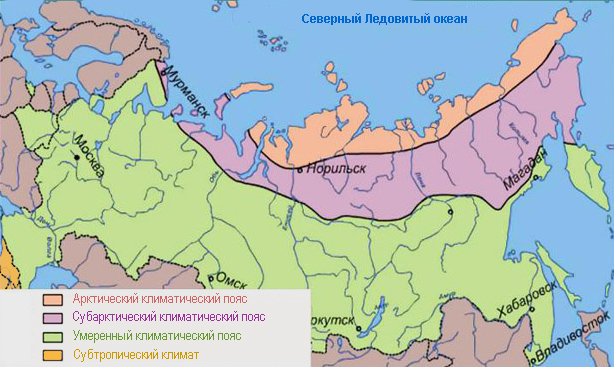Pomirniy klimatichny belt number of fallen trees
subarctic climatic belt pass between 60 and 70 about the winter latitude. The movement in the arctic zone is twisting in the suvoric weather minds: protracted cold winters, strong winters, swampy weather, bright years warming up to +15 o C.
from arctic belt so Wash the weather fail great number fallen down, three with a medium temperature and a fewer zones of frozen ground. There is a great number of pains to be explained by bright falloffs, which cannot be increased due to the weak son of Sontsya. Industrial development in such a culture is unfortunate, for that there is minimal population density in Russia.
Climate of the subarctic belt of Russia
With the weather in the Russian Subarktika, there are streams of worshipers: in the middle latitudes, And the charge is arctic. The Siberian part of the small bends is continental in nature. When the weather is calm, clear, the weather gets very cold.

(Map-scheme of the climatic zones of Russia)
Average indicator of litter on rural subarctic dilens climatic zones Russia -300-400mm, the main part of the seizures is on lіtnі boards, Mokriy snig and winter snigopadi. Comrade snigu on the Central Siberian Plane, a reach of 1 meter on the winding grabs and does not change 40cm in the winter-skidny part.
Mista and regions of the subarctic belt of Russia
At the climatic date injected into the mice of growth: in the coastal regions, by far the most number of fallen leaves, ale bolsh warmer lito... The tables have selected tributes for the last ten rockets about climatic minds Russian settlements, which are located in Subarktika:
From Russia to subarctic zone to carry out the winter skid to Siberia, Dalekiy Skhid, paved islands The Barents Sea. Naipivnichnisha inhabited a point on the planet - the village of Oymyakon roztashovane in the subarctic belt. The temperature minimum for winter here will be fixed at -70.5 o C. Record low indicators are explained by the growth of the village. It is located in the natural "cold cellar" - the mainland depression, otochenii at all sides of the high ridges, go through the warm disastrous masi can't. It is easier for human organisms to endure strong frosts in winter and winter in Yakutia, less frost in the Arctic, since the speed of wind is much less
